When planning a new countertop or flooring project, many homeowners find themselves weighing natural stone vs engineered stone. Common comparisons include granite vs quartz, marble vs engineered marble, and even branded options like Caesarstone vs other engineered quartz. Both natural and engineered stones are popular for their beauty and durability, but they have key differences. In this guide, we’ll break down what each material is, compare their pros and cons, and help you decide which option best fits your needs. The goal is to provide a balanced view – highlighting the unique appeal of natural stone while acknowledging the strengths of engineered products – so you can make an informed decision.
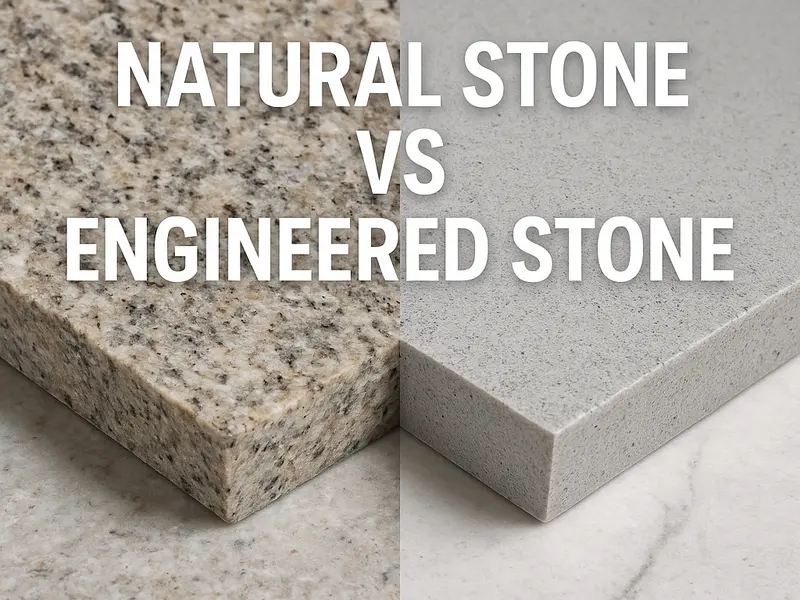
What is Natural Stone?
Natural stone is exactly what it sounds like – stone quarried from the earth and cut into slabs or tiles. Examples include granite, marble, quartzite, slate, travertine, and more. Each piece of natural stone is one-of-a-kind, featuring unique patterns, colors, and veining created by geological processes over millions of years. Granite and quartzite are known for their exceptional hardness and durability, while marble and limestone are prized for their classic elegance (albeit softer and more porous). Natural stone has been used in construction and decoration for centuries, valued for its natural beauty and long-lasting strength. Because it’s formed by nature, no two slabs are identical – this uniqueness is a large part of its appeal. However, natural stones are porous to varying degrees (especially marble and limestone), meaning they may require sealing and careful maintenance to prevent stains.
What is Engineered Stone?
Engineered stone (also called reconstituted stone, artificial stone, or composite stone) is a man-made material created to mimic the look of natural stone while enhancing certain properties. It’s made by combining crushed natural stone (like quartz or marble chips) with binders (resins) and pigments, then forming them into slabs under high pressure and heat.
The most common type is engineered quartz, which usually contains around ~90% ground natural quartz and 10% resin and pigments. There are also engineered marbles (sometimes called cultured marble) made from marble dust/chips plus resin.
Engineered stone offers a uniform, controlled appearance – manufacturers can create slabs in a wide range of colors and patterns, some nearly identical to marble or granite, others completely unique. Because of the resin binders, engineered stones are non-porous, highly resistant to stains, and do not require sealing like natural stone. They are also very hard and durable against scratching or chipping. On the downside, the resin content means engineered stone is less heat-resistant than natural stone – placing a hot pan directly on a quartz countertop, for example, can scorch or crack it, so heat protection is needed.
Engineered stone is typically fabricated in factories, resulting in consistent quality and slab sizes, and it tends to be lighter weight than equivalent thickness of natural stone, which can simplify installation.
Also READ | The Reason for Material Selection: Engineered Stone Vs Natural Stone
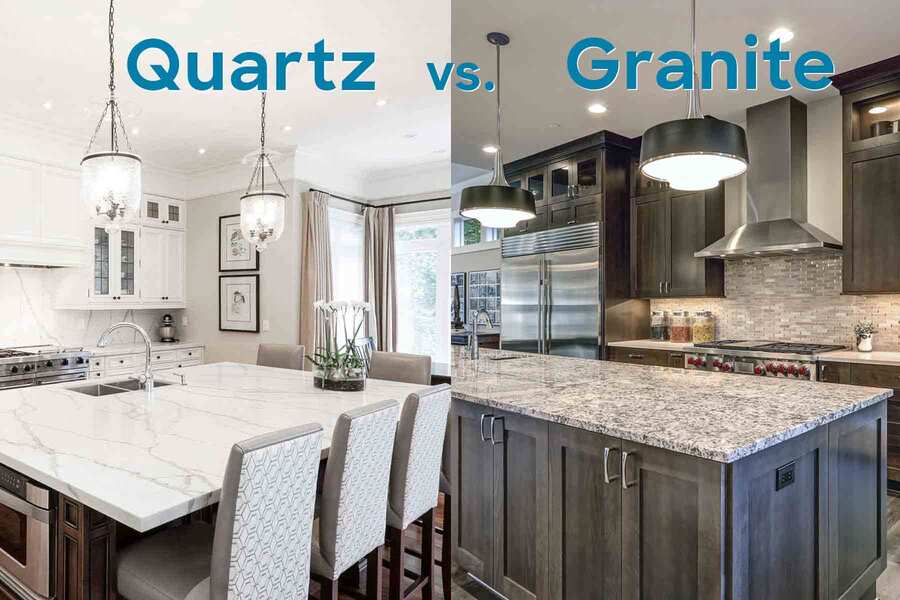
Engineered Stone vs Granite
Granite has long been a gold-standard for countertops and flooring – it’s a natural igneous stone famed for its strength, speckled beauty, and heat resistance. How does it compare to engineered stone (like quartz)?
Appearance
Granite is naturally formed from molten magma, composed of interlocking crystals of quartz, feldspar, mica, etc. This gives it a distinctive granular look with infinite variations in color and pattern – from salt-and-pepper styles to dramatic flowing veins in exotic granite types. No two granite slabs are identical, which is part of their charm. Engineered stone (Quartz) is manufactured in controlled colors and patterns. If you prefer a consistent, uniform look, engineered stone delivers – you can pick a specific color/pattern and expect your whole countertop to look just like the sample. Some engineered stones are designed to mimic granite or marble, while others have completely uniform patterns or even solid colors. The downside is they lack the natural one-of-a-kind character of real granite. It really comes down to taste: do you want the unique, organic patterns of nature or the clean, predictable design of a man-made product?
Durability and Hardness
Both granite and engineered quartz are very durable, but with different strengths. Granite is extremely hard and highly heat-resistant – you can place hot pots or pans on granite without fear of burning the surface (granite can take heat that would melt or scorch other materials). Granite is also quite scratch-resistant; you generally won’t scratch granite with knives (it will actually dull your knife). However, granite’s hardness can make it slightly more brittle – a hard impact on an edge might chip it (chips can be repaired, though). Engineered quartz is also very hard (quartz mineral is a 7 on Mohs hardness, similar to granite’s minerals) and is even more resistant to scratches in many cases. Normal use won’t scratch an engineered stone surface. The one area it falls short is heat: the resins in quartz countertops can only withstand about 150°C (300°F) or so. Exposing an engineered stone slab to something like a hot pan straight from the stove or a baking sheet from the oven can cause discoloration or cracking. Therefore, trivets and hot pads are a must on engineered stone, whereas granite can handle incidental heat much better. In daily use, if you’re careful with hot items, both materials hold up excellently against scratches and wear. Neither is easily dented or cracked under normal kitchen use (they’re both far superior to softer surfaces like solid surface or wood in that regard).
Porosity and Stains
Granite is a natural stone with pores and micro-fissures. Especially lighter-colored granites can absorb liquids and stain if not sealed. Granite countertops typically need to be sealed upon installation and resealed every 1-2 years (some dense granites less often). Spills like oil, wine, etc., if left on unsealed granite, could seep in. Engineered stone is non-porous due to the resin binding – it will not absorb liquids, and thus is highly resistant to staining. You don’t need to ever seal a quartz countertop, and you can generally wipe up even coffee or red wine without it leaving a mark. This makes engineered stone extremely popular for low-maintenance kitchens. It’s also more bacteria-resistant since there are no pores for microbes to hide in. Granite when sealed is also sanitary for kitchen use, but you have to be diligent about maintaining that seal.
Maintenance
Because of the above, granite requires a bit more maintenance – mainly the periodic sealing, and using pH-neutral or granite-friendly cleaners (acidic or abrasive cleaners can dull the seal or etch certain minerals). Engineered stone’s maintenance is minimal – routine cleaning with soap and water or any gentle household cleaner is fine (just avoid extremely harsh chemicals or solvents which could potentially degrade the resin). No sealing, no special polishes needed. Both materials are durable for decades; granite might require a professional re-polish or chip repair once in a blue moon, whereas engineered stone might need a professional fix if a crack or scorch happens (which is rare with normal use).
Cost
Is engineered stone cheaper than granite? The answer: it depends on the specific granite and the brand of engineered stone. In general, engineered stone and granite have overlapping price ranges. Engineered quartz tends to have predictable mid-range pricing, whereas natural stone can range from very affordable to extremely high-end. For example, common varieties of granite can be quite affordable (comparable to or even less than quartz), but exotic or rare granite slabs can cost significantly more. According to industry data, engineered stone usually falls in the range of about $50 – $120 per square foot installed, whereas natural stone spans a broader range from $50 up to $200+ per square foot for rare materials. Engineered stone is often less expensive than high-end natural stone but comparable to mid-range natural options. Also note installation costs: granite, being heavier and sometimes trickier to fabricate (due to natural brittleness or patterns), can have higher installation/labor costs, whereas engineered slabs, being uniform, can be easier to cut and install with slightly lower labor expense.
In summary, common granites and engineered quartz are roughly on par in cost, while very premium granite will cost more. If budget is tight, you might find a broader selection of mid-priced engineered stone to choose from, whereas natural stone options in the low price tier might be limited to more common colors of granite.
In the end, granite vs engineered stone is often a toss-up based on your priorities:
- If you absolutely require highest heat resistance or love natural variation, granite wins in those categories.
- If you prefer easy maintenance and guaranteed consistency in color/pattern, engineered quartz is extremely attractive.
Both are excellent for durability and will add value to your home. It often comes down to aesthetic preference – the natural elegance of granite or the sleek uniformity of quartz – and practical factors like whether you’re willing to periodically seal the granite or be cautious with hot cookware on the quartz.
READ: Original Environmentally Conscious Green Building Material. Is Granite Sustainable?
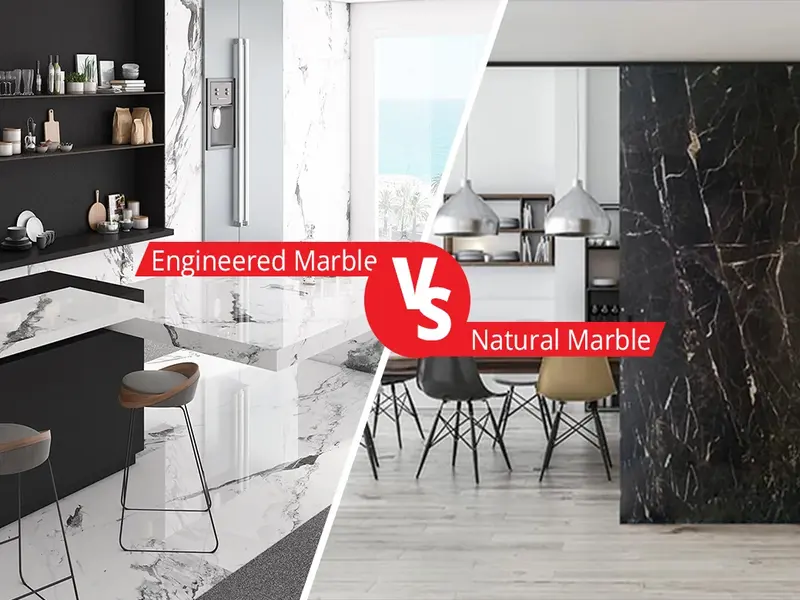
Engineered Marble vs Natural Marble
Marble is a timeless natural stone, but it’s also one of the softer, more high-maintenance materials. This has led to the creation of engineered marble, which aims to offer a marble-like look with improved performance. Let’s compare engineered marble vs natural marble:
Composition & Appearance
Natural marble is quarried in slabs with stunning veins and variation; each block of Carrara, Calacatta, or other marble has unique patterns formed by nature. Engineered marble is made from real marble chips and dust combined with resin and pigments, then cast into molds or blocks and cut into slabs. It often looks like marble but with a more uniform pattern. Manufacturers can add pigments or even bits of glass or metal to achieve certain looks. While engineered marble can resemble natural marble’s elegance, true marble lovers might notice the difference – natural marble’s rich, varied veining and subtle depth are hard to perfectly replicate (experts can usually tell the difference on close inspection).
Durability & Performance
Marble (calcite-based stone) is relatively soft and prone to scratching, chipping, and etching (dulling when exposed to acids like vinegar or lemon). It’s also porous and can stain without proper sealing. Engineered marble, by contrast, is designed to overcome some of marble’s weaknesses. It’s less porous (the resin binds the particles and often a protective gel coat is applied), so it resists moisture and stains better than natural marble. It’s also more resistant to scratches or cracks since the resin gives it some flexibility. This means engineered marble surfaces generally won’t etch from acidic spills and won’t easily absorb oils or colorants – a big advantage for bathroom vanities or flooring. That said, engineered marble is not as heat-resistant: the resin can be damaged by high heat. Natural marble can actually handle higher heat without burning (after all, it formed under heat and pressure in the earth). If you place a hot curling iron or pot on engineered marble, there’s a risk of scorching or even warping, whereas a natural marble slab would be unfazed by the temperature (though it could suffer thermal shock in extreme cases).
Maintenance
Natural marble requires regular sealing and gentle care – you must wipe spills quickly, use pH-neutral cleaners, and accept a patina over time. Engineered marble is lower maintenance, generally not requiring sealing (or at most only infrequent sealing) and tolerating regular cleaners without etching. It does not discolour or yellow with age the way some untreated natural marbles might. However, one caveat: if engineered marble has a glossy gel coat, you should avoid abrasive cleaners that could dull it, and over many years that top coat could wear and potentially need refinishing.
Cost & Installation
Natural marble is a premium material – certain varieties can be very expensive. It’s also heavy and must be installed by skilled professionals, often at higher labor cost. Engineered marble tends to be more affordable than high-end natural marble. The slabs (or tiles) are often lighter and can be produced in thinner profiles, making handling and installation easier and cheaper. For large projects or tight budgets, engineered marble can provide a luxurious look without the same price tag.
In short, engineered marble offers a marble-like aesthetic with improved resistance to stains and scratches and lower upkeep. Natural marble offers genuine one-of-a-kind beauty and better heat tolerance, but demands more care. If you love the luxury and uniqueness of natural marble and are prepared to maintain it, it’s hard to beat. But if you want a similar elegant look in a high-use area (like a busy family bathroom or a commercial lobby) without the worry of staining or etching, engineered marble is a compelling alternative.
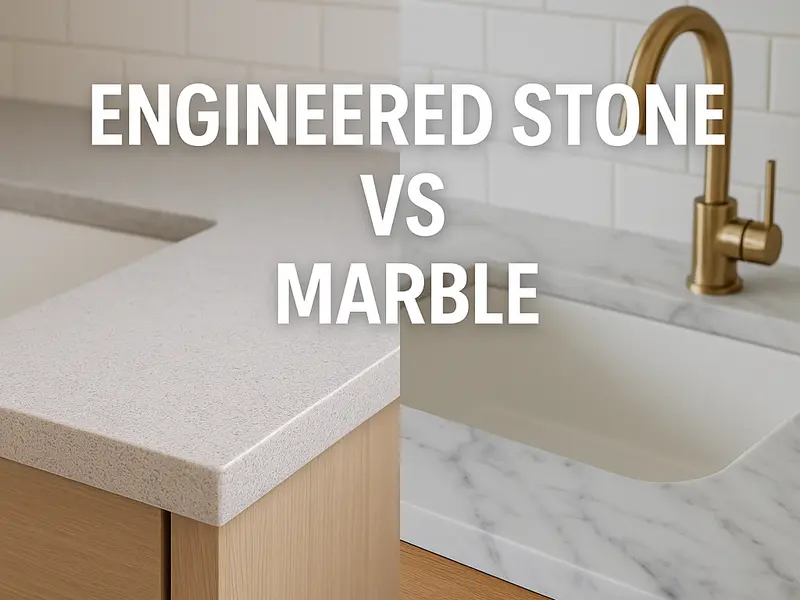
Engineered Stone vs Marble
Now let’s compare engineered stone (quartz) to natural marble – a very common dilemma for those who love the look of marble but worry about its upkeep. This is slightly different from the earlier “engineered marble vs natural marble” section; here we’re contrasting engineered quartz against marble, because many engineered quartz products are explicitly designed to imitate marble (like Carrara-look or Calacatta-look quartz).
Aesthetic
Natural marble is revered for its elegant, classic beauty – the flowing veins, the luminescent quality of the polished stone, and the uniqueness of each slab. It adds a certain luxury and warmth that’s hard to replicate. Engineered quartz can be made to look very similar (white base with gray veins, etc.), and some high-end quartz patterns are impressively realistic. Quartz lacks the depth or subtle light-transmission of real marble (marble has a bit of translucence that gives it a “glow” in certain light). To most observers, a well-made marble-look quartz counter is beautiful – and it stays looking perfect over time (whereas real marble develops a patina of tiny imperfections). If you absolutely must have genuine natural stone for its prestige and authenticity, marble is the winner. But if you’re happy with a close replica that offers more practicality, engineered stone provides that uniform marble design without the natural variation (which some people actually prefer to avoid busy patterns or surprises in the slab).
Practical Performance
This is where engineered stone really shines. Engineered quartz is far more durable than marble for everyday use. Marble is soft (Mohs ~3) and etches on contact with acids – for example, a lemon slice, vinegar, or even some cleaners can leave dull spots on a polished marble counter. Quartz (engineered) is non-reactive to common household acids and won’t etch or dull. Marble can scratch from knives or metal utensils; quartz is highly scratch-resistant (Mohs ~7, similar to steel). Marble is porous and can absorb oils or colored liquids, causing stains, whereas quartz is non-porous and impervious to stains.
In a kitchen scenario, engineered stone is undoubtedly easier to live with – no fear of red wine spills or tomato sauce leaving a mark, and you don’t need to baby it while cooking or cleaning. Marble in a kitchen, conversely, requires a mindful owner who accepts that the surface will age and wear with use (some people love the patina; others would be upset by every scratch or wine ring).
Heat and Chemicals
One of the few advantages of natural marble in performance is that it won’t scorch from a hot pot – marble can handle heat somewhat (though extreme heat could cause it to crack, it won’t burn). Engineered quartz will get damaged by high heat, as mentioned before. Also, marble is more resistant to UV sunlight – if you have a sunlit area or want to use it outside, marble won’t fade (it might weather, but not discolor). Standard engineered quartz can yellow or fade in direct UV over time and thus is not recommended for outdoor use or sun-heavy rooms (unless you choose special UV-resistant quartz). So for an outdoor kitchen or a sunroom, natural stone (like marble or granite) is usually preferred, as most engineered stones’ warranties do not cover outdoor use.
Maintenance
Marble needs regular sealing and careful cleaning. Quartz needs no sealing and is as low-maintenance as it gets (just wipe it down). If you want the look of marble but zero hassle, engineered quartz is the clear choice. This is why so many commercial projects (restaurants, hotels) and busy households opt for quartz that looks like marble – it provides a similar upscale appearance without the upkeep and vulnerability.
Cost
Surprisingly, real marble can sometimes be cheaper than engineered stone, or vice versa, depending on what you choose. Common marbles like Carrara might be in the lower range of natural stone pricing, potentially comparable or even less than a mid-range quartz. However, many marbles (especially imported Italian ones) are expensive, and installation costs for marble might be higher due to specialized handling (marble is trickier to work with because it can crack and requires expert finishing). Marble also may incur costs later (professional repolishing or repair if needed). Engineered stone is mid-priced typically – there are expensive premium quartz designs too, but generally you’ll know the price upfront and there are fewer hidden costs (and virtually no maintenance cost over time). If budget is key and you want that look, you’ll have to compare specific quotes – don’t assume one is always pricier than the other. Just remember to factor in the cost of maintenance/repairs with marble (sealing it regularly, possibly fixing etches or stains down the line).
Bottom line: Natural marble vs engineered quartz comes down to romance vs convenience. Marble offers a natural, timeless luxury and each slab is a piece of earth’s art – if that is your passion and you don’t mind caring for it, it can be wonderful (especially in lighter-use areas like a bathroom vanity or a decorative feature). Engineered stone offers a practical way to enjoy the marble aesthetic in high-traffic areas like a kitchen or busy bathroom, where you might not want to worry about every spill. It’s not exactly the same, but it’s close enough that many people choose it and never regret avoiding the headaches of marble maintenance.
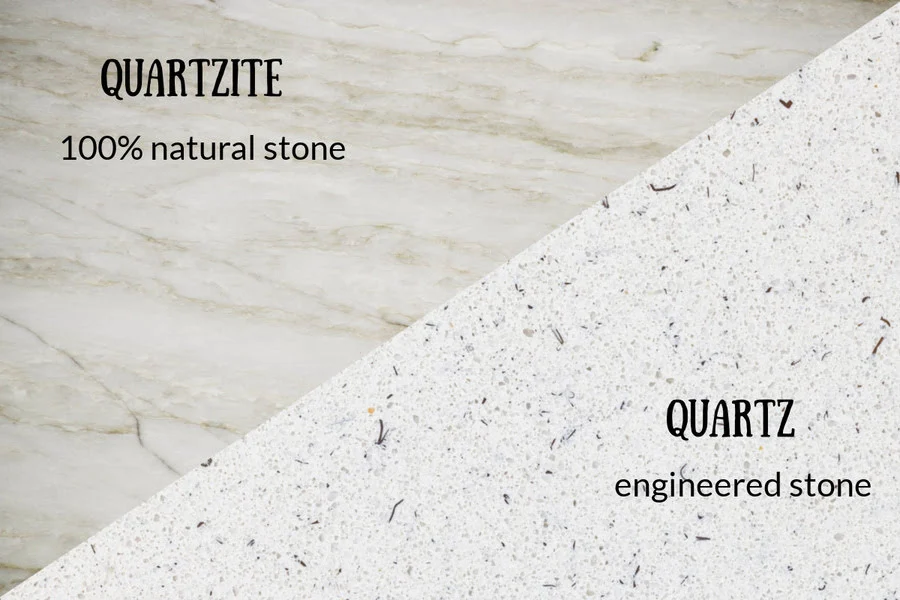
Engineered Stone vs Quartz – Are They the Same?
A common point of confusion is the terminology of engineered stone vs quartz. The short answer: Yes, in most cases “quartz” countertops are engineered stone. In fact, engineered quartz is such a dominant product in the engineered stone category that people often use “quartz” and “engineered stone” interchangeably. A quartz countertop is an engineered stone surface made of natural quartz aggregates and resin, as described above. So if you’re comparing “engineered stone” to “quartz,” you’re often talking about the exact same material.
However, note that natural quartz does exist – quartz is a mineral found in many rocks. There is a natural stone called quartzite (often white or gray with marble-like veining) which is sometimes confused with engineered quartz. Natural quartzite vs engineered quartz is a different comparison: quartzite is a 100% natural stone that is extremely hard (harder than granite) and heat-resistant, whereas engineered quartz is man-made and not as heat-tolerant, though more stain-resistant.
In summary, “quartz” in the context of countertops refers to engineered quartz stone, a subset of engineered stone. Meanwhile, other terms like “artificial stone”, “man-made quartz”, or “reconstituted stone” all refer to these engineered composites as well – different phrases, same category of product.
ALSO READ | Full Guide: Quartzite vs Quartz – Cost, Durability, Use Cases
Caesarstone vs Engineered Stone
Some confusion arises when comparing specific brands to generic terms, for example: Caesarstone vs engineered stone. Let’s clarify: Caesarstone is engineered stone. In fact, Caesarstone is one of the leading brand names of engineered quartz surfaces worldwide. It’s an Israeli company that pioneered quartz countertops in the 1980s. So asking “Caesarstone vs engineered stone” is like asking how a particular brand compares to the generic category. The material composition is essentially the same – Caesarstone’s products are around 90% natural quartz bonded with resins, just like other quartz brands.
That said, Caesarstone has built a reputation for quality control, innovative designs, and marketing. Here are a few points to consider:
Quality
Caesarstone is often regarded as a high-quality product with a long track record. However, these days most major engineered quartz brands have comparable quality. The basic manufacturing technology (the Breton process) is used by many, so differences are minor. As one industry observer put it, “They are all quartz... just different brands.”. Some quartz brands may vary the exact resin formulas or quartz content slightly (e.g., one might be 93% quartz vs another 90%), but in practice the performance is very similar. All good brands will be very durable and come with warranties.
Design Choices
One reason someone might specifically choose Caesarstone is for a particular color or pattern they offer. Caesarstone has a wide range of designs, including some signature looks that customers love. Competing brands (Silestone, Cambria, Q Quartz, etc.) also have extensive collections. In many cases, you can find a similar color/pattern from another brand if you look around. Caesarstone might have the exact “perfect” design for your kitchen, or you might find an equivalent from a competitor at a different price.
Cost
Caesarstone tends to be priced at the premium end of the spectrum for quartz. You may pay a bit more for the brand name. Other engineered stone brands can be slightly cheaper for similar thickness and style. However, pricing also depends on the specific color series (Caesarstone has some entry-level colors and some deluxe ones). Generally, Caesarstone’s prices are in line with other top-tier quartz brands, and all are in the same ballpark as mid-to-high range granites. If budget is a concern, there are less expensive quartz brands (including some imported ones) that undercut Caesarstone, but be cautious with extremely cheap no-name quartz as the quality and support may not be as reliable.
Performance
In terms of day-to-day use, Caesarstone and other engineered quartz perform the same. All are non-porous, scratch-resistant, and not fully heat-proof (no brand of quartz is immune to thermal damage). Caesarstone offers warranties (often around 10 or 15+ years or even lifetime in some markets) on their slabs; other brands have similar warranties. When properly installed and cared for, any good engineered stone should last decades without issues.
So, which is better: Caesarstone or another engineered quartz? The honest answer: there’s no significant difference in material properties, only in the aesthetic options and brand services. Caesarstone might give you peace of mind due to its reputation and large network of suppliers, whereas a less-known brand might save you some money. If you find a Caesarstone color you adore, you can be confident it’s a top-quality engineered stone. If you’re indifferent to brands, shop around various quartz lines – often you can prioritize color/pattern and warranty over the name.
In summary, Caesarstone is a type of engineered quartz, not a separate category. It exemplifies the consistency, durability, and style that engineered stones offer, with the main difference being its specific designs and brand assurance.
(Note: Caesarstone is just one brand; other well-known engineered stone brands include Silestone, Cambria, Quartz Master, etc. All share the core characteristics of engineered stone outlined earlier.)
Quartz vs Engineered Stone: What’s the Difference?
As covered earlier, if we’re talking about countertops, quartz vs engineered stone is not a versus at all – they refer to the same family of materials. To reiterate: Engineered stone is the broad category of man-made stone composites, and “quartz” has become a shorthand for engineered stone countertops because the vast majority are made with quartz aggregates.
In other words, engineered quartz is a type of engineered stone. So if someone asks “Is quartz different from engineered stone?” the answer in the context of surfaces is no, quartz is engineered stone (specifically quartz-based engineered stone).
However, some confusion can occur because “quartz” is also a natural mineral. There is no such thing as a “solid slab of pure quartz” used for counters – when people say natural quartz countertop, they usually mean quartzite or another natural stone predominantly composed of quartz. If you encounter the term natural quartz vs engineered quartz, it’s comparing the geological material vs the manufactured product. Natural quartz (quartzite) is quarried like any stone; it’s extremely hard and heat-resistant, but still needs sealing and can have limited colors (mostly white/gray). Engineered quartz is what we’ve been discussing – made in a factory, non-porous, available in many colors/patterns (even some that look like natural quartzite or marble).
So to put it simply: Quartz = Engineered Stone (in the countertop industry). Any differences would only be between specific brands or formulations, not the general concept. If you’re shopping for counters and see “engineered stone,” “quartz surface,” “man-made stone,” or “artificial stone,” these all typically mean the same thing – a engineered composite, most likely quartz-based. There’s no functional difference – just make sure you’re not mixing it up with quartzite, which is a totally natural stone. For your purposes, treat quartz and engineered stone as identical categories, and focus more on comparing those to natural stones or to other materials.
Composite Stone vs Granite
The term composite stone generally refers to engineered stone as well – “composite” because it’s composed of multiple ingredients (stone + resin). Sometimes people also say “reconstituted stone” or “agglomerate stone”, which are synonyms. Here, we’ll interpret composite stone vs granite as essentially engineered stone vs granite, which we covered earlier in detail.
Pros and Cons of Natural Stone Vs. Engineered Stone
To crystallize the differences, here’s a side-by-side comparison of Natural Stone vs Engineered Stone on key factors:
| Factor | Natural Stone (Granite, Marble, etc.) | Engineered Stone (Quartz, etc.) |
|---|---|---|
| Appearance | Unique, one-of-a-kind patterns created by nature; each slab is distinct. Can be very luxurious (e.g., rich veining in marble, bold crystals in granite). | Consistent, uniform look – predictable patterns and colors. Can mimic natural stone or offer designs not found in nature. Lacks natural variation (which some prefer to avoid surprises). |
| Durability | Generally very durable. Hardness varies by stone (granite/quartzite are extremely hard; marble is softer). Highly heat-resistant(especially granite/quartzite – can handle hot cookware). May chip if struck hard on edges (repairable). | Highly durable and strong, with excellent scratch and impact resistance. However, resin binders limit heat resistance – high heat can damage it. Not recommended to place extremely hot items directly on surface. |
| Porosity & Stains | Porous to some degree. Most natural stones require sealing to prevent stains. If left unsealed or improperly maintained, can absorb liquids and harbor bacteria. Acids can etch calcite-based stones (marble, travertine). | Non-porous and stain-resistant – does not require sealing. Spills stay on the surface and wipe off easily. Very hygienic surface (no pores for bacteria). Resistant to household acids/chemicals that could etch natural stone. |
| Maintenance | Moderate to high maintenance: needs periodic sealing (especially marble, granite less frequently). Use gentle cleaners to avoid etching or stripping sealant. May need occasional re-polishing over years (for marble). Care needed to avoid stains or scratches on softer stones. | Low maintenance: no sealing ever needed. Routine cleaning with mild soap/water is sufficient. Very difficult to stain or scratch, so upkeep is minimal. Essentially “install and enjoy”with basic cleaning. |
| Customization | Limited to what nature provides. You get the colors/patterns available from quarries. Slab sizes are fixed by quarry yield (very large seamless pieces can be hard to get). Can’t customize pattern or color, but can select from a wide range of natural options. | Manufacturers offer extensive colour palettes and patterns, including those resembling various stones or completely original designs. Consistent slabs mean you can match pieces easily. However, you can’t truly replicate the one-of-a-kind aura of natural stone. |
| Environmental | Natural product, minimal processing (cutting, polishing). Quarrying impacts include landscape disturbance and resource depletion, especially for rare stones. On the plus side, natural stone is long-lasting (decades of use) and fully recyclable or reusable. | Manufactured process uses resins (which are petrochemical products) and energy in factories. There is some environmental impact in production. Some brands incorporate recycled materials (e.g., recycled glass or stone scraps) to be eco-friendlier. |
| Cost | Varies widely: Some common stones are affordable; exotic marble or granite can be very expensive. Installation often costly for heavy, hard-to-work stones. Natural stone generally has higher initial material cost for premium grades. | Moderate cost: Typically priced comparable to mid-range natural stone. Less variance – pricing is more predictable (depends on brand, design, thickness). Installation can be somewhat easier (uniform slabs), sometimes reducing labor cost. Ultra-budget options exist (but beware quality). Overall often a bit cheaper than high-end natural stone but not necessarily cheaper than all natural stone. |
| Usage Suitability | Great for high-heat and outdoor applications (granite/slate for BBQ tops, fire surrounds). Ideal if you value natural beauty in focal points. Some softer stones (marble/limestone) less ideal for heavy-use kitchens but fine for baths, floors (with care). Exterior use no problem for most natural stones (just weather normally). | Best for indoor use – kitchens, bathrooms, commercial countertops, flooring. Excels in heavy-use areas where stain resistance is key (kitchens, bars, kids’ bathrooms). Not usually used outdoors (unless formulated for it) due to UV/heat sensitivity. Not suitable for fireplace hearths or oven surrounds where direct high heat present. For indoor surfaces, extremely versatile. |
What Should You Choose?
With all this information, you might still be asking: Which one is right for me? The choice between natural and engineered stone depends on your priorities, use-case, and personal taste. Here are some guidelines to help you decide:
If you love the authentic, natural look and don’t mind maintenance
Choose natural stone. For example, if the sight of a unique granite slab or the elegance of real marble makes your heart sing, natural stone will give your space a one-of-a-kind character that engineered stone can’t fully replicate. Natural stone is often associated with higher-end, luxury designs and can increase real estate appeal with its prestige. Just be prepared to care for it: sealing the surface periodically, using coasters on marble, cleaning up spills, etc. Many homeowners find this trade-off worthwhile for the beauty and “soul” that natural stone brings.
If you need a surface that stands up to heavy use with minimal fuss: Engineered stone is likely better. In a busy family kitchen where spills, coloring projects, or a lot of cooking happens, quartz countertops are extremely practical – no worrying about the kids spilling juice or someone accidentally leaving a stain. Engineered stone is also a top choice for commercial settings (restaurants, cafes, retail) where maintenance needs to be easy and the look uniform. If you simply want the look of marble or granite but none of the headaches, engineered stone provides that peace of mind.
For kitchens and bathrooms
Consider your habits. Do you frequently set hot pans directly on the counter or love to bake (and therefore have lots of hot cookie sheets)? If so, granite or quartzite (natural) might be better around the cooktop area for that heat tolerance (though trivets are always recommended, granite gives a safety net). Are you an avid baker who might appreciate marble’s cool surface for rolling dough? Natural marble is great for that, but you could also get a small marble pastry slab and still do quartz for the rest. If you absolutely cannot stand the idea of a countertop staining or etching, then go engineered – you’ll have zero worry in that department.
For bathroom vanities, engineered stone is superb (toothpaste, makeup, etc. won’t stain it), but some people love the spa-like feel of real marble in a bathroom – if the usage is lighter (no oils, and you can wipe cosmetics or hair dye spills quickly), marble can be fine there. Think about how much effort vs aesthetic you’re willing to invest.
Outdoor use or sun-exposed areas:
Natural stone is the safer bet. If you’re doing an outdoor kitchen, BBQ countertop, or a patio bar, go with a natural granite or other stone that’s proven outdoors. Engineered quartz will fade or discolor under UV and most brands explicitly void the warranty if used outside. There are new quartz products marketed as outdoor-safe, but natural stones have been used outside for millennia – you can trust granite, slate, bluestone, etc., to handle the elements.
Budget considerations
Get quotes for a few options. Sometimes a readily available natural stone (especially from local quarries) can be more affordable than a fancy imported engineered slab. Other times, a standard engineered stone might undercut an exotic granite. If you’re on a tight budget, also consider that with natural stone you might need to pay for periodic sealing and potentially refinishing down the line, whereas engineered stone has virtually no ongoing costs. But the upfront differences have narrowed – these days it’s often a matter of preference rather than major cost savings one way or the other.
Resale and long-term value:
Both natural and engineered stones are considered quality surfaces and will add value to a home. Traditional wisdom says high-end homes tend to feature natural stones for their luxury appeal. However, quartz has become so popular that prospective buyers generally view both as desirable. If you’re designing your “forever kitchen,” choose what you will enjoy. If you’re renovating to sell, neutral-colored quartz is a safe, broadly appealing choice; but a stunning natural stone feature could also wow buyers. It truly depends on the market and style of the home.
Importantly, natural stone and engineered stone aren’t enemies or mutually exclusive. They are often used together in complementary ways. For instance, an kitchen might have a showpiece natural marble island but use quartz for the tougher work countertops, balancing beauty and performance. Or a hotel might use natural stone in the grand lobby, but engineered surfaces in guest room baths for easy maintenance. There’s also recognition that the supply of high-quality natural stone is finite – we can’t quarry enough marble or granite for every single project in the world sustainably. Engineered stone helps fill that demand by using crushed stone (often even recycling the waste from quarries) to create new surfaces, taking pressure off natural resources.
Conclusion
In the end, the choice between natural stone and engineered stone comes down to your individual needs and values. Natural stones like granite and marble offer timeless beauty, unique patterns, and a direct connection to nature’s artistry. They have been the centerpiece of elegant homes and buildings for centuries. Engineered stones like quartz bring modern convenience, consistency, and innovative design options, solving some of the practical limitations of natural materials (like porosity and maintenance). Neither is categorically “better” – each has its pros and cons (as we’ve summarized above), and often the best choice is context-dependent.
If you cherish the idea that your countertop is a one-of-a-kind slab hewn from the earth, with its own story and character, then you’ll likely lean toward natural stone. Every glance at its swirling pattern can be a joy, and with a bit of care it will last for generations. On the other hand, if you want a surface that you can set and forget – one that effortlessly handles the spills, splashes, and surprises of everyday life while still looking beautiful – engineered stone is a fantastic solution, giving you style with peace of mind.
It’s also perfectly valid to use a mix of materials in your space to capture the advantages of both. For instance, a kitchen could have a statement natural stone backsplash or island, paired with quartz counters for work areas. This way you get the “wow” factor and the worry-free surfaces where they matter most. Remember, these materials can complement each other; engineered stone exists in part because there isn’t enough quarry-yielded natural stone for every application, and because not every scenario is ideal for natural stone (like a busy juice bar countertop!). They fill in where nature might be limited, and vice versa.
Finally, consider the long-term happiness: You want to be delighted with how your kitchen or bath looks and functions years down the road. Whichever you choose, invest in a quality product and professional installation. Both natural and engineered stones are premium surfaces that add value and beauty to your home. By understanding their differences, you can make a choice that you’ll be satisfied with every time you see and use that surface.
In summary, if you desire the irreplaceable beauty of nature and are prepared to maintain it, you’ll never regret going with natural stone. If you prefer modern practicality with a beautiful but controlled aesthetic, you’ll be very pleased with engineered stone. Either way, you’ll end up with a gorgeous surface – so it’s truly about matching the material to your lifestyle and vision. Happy designing, and enjoy the lasting splendor of whichever stone you select!


 Fact Checked
Fact Checked




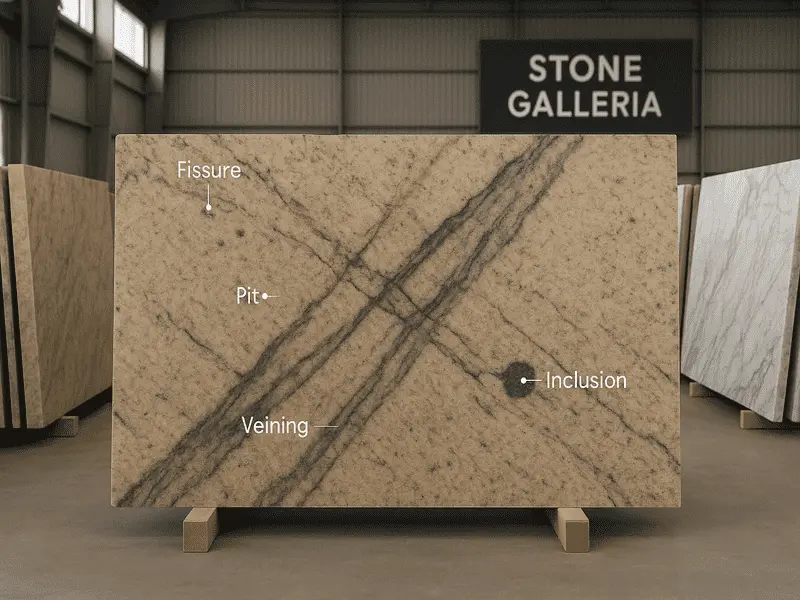
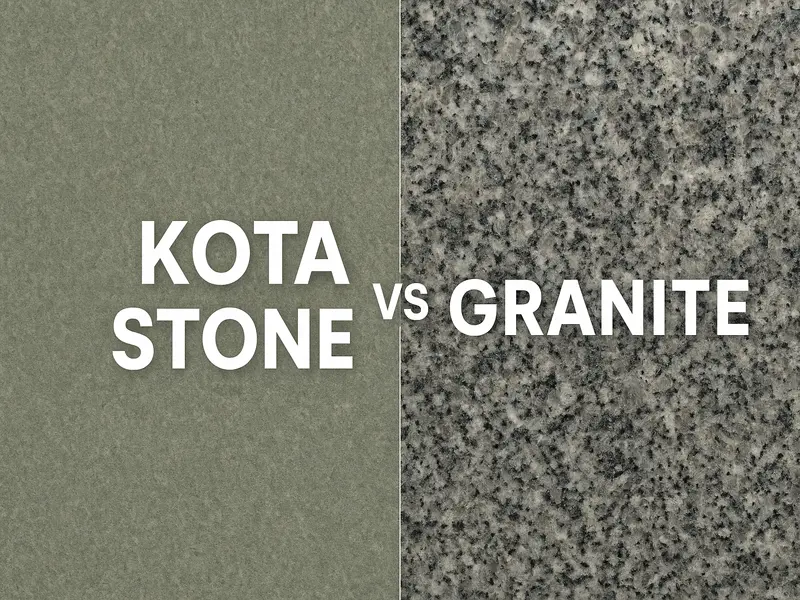



![Latest GST on Granite Slabs & Blocks [2025 Chart + HSN + Price Examples]](https://stonegalleria.in/admin/images/blog/latest-gst-on granite.webp)




